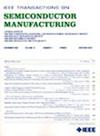Surface Reconstruction for Enhancing the Overlay Modeling Optimization Procedure in Photolithography Processes
IF 2.3
3区 工程技术
Q2 ENGINEERING, ELECTRICAL & ELECTRONIC
引用次数: 0
Abstract
In the photolithography process of integrated circuit (IC) manufacturing, overlay (OL) control is a key factor for successful exposure. Overlay control is achieved by creating models that can estimate the expected overlay error, so that this can be corrected before the wavefront reaches the wafer surface. Such models consist of basis functions, influenced by application-controllable variables such as process settings, tool characteristics, and field-related factors with their corresponding model parameters. The process of tuning the model parameters involves several time-consuming sensor measurements on markers distributed across the wafer surface and significantly impacts the throughput performance of the exposure system. For this reason, a strategic selection of wafer markers is necessary. In this paper, we propose a methodology to improve the overlay modeling process by exploiting Surface Reconstruction (SR). SR is used as an intermediate step, during the parameter estimation process, to generate additional data from a strategically selected set of markers that are spatially uniform and provide maximum information gain. The proposed method reconstructs the wafer surface by incorporating spatially interpolated estimates derived from the physical insights of existing measurements. This augmented data set, comprised of measured and synthetic overlay data, serves as a comprehensive input for the parameters’ tuning process leading to more accurate overlay modeling. The proposed method is evaluated using real-industry data from a semiconductor process of 300mm diameter wafers. The results demonstrate a significant reduction in the overlay residuals in both x and y directions.改进光刻过程中覆盖建模优化程序的表面重建
在集成电路(IC)制造的光刻工艺中,覆盖层(OL)控制是成功曝光的关键因素。叠加控制是通过建立模型来实现的,该模型可以估计预期的叠加误差,以便在波前到达晶圆表面之前对其进行校正。这些模型由基础函数组成,受应用可控变量的影响,如工艺设置、工具特性和与现场相关的因素及其相应的模型参数。调整模型参数的过程涉及到对分布在晶圆表面的标记进行多次耗时的传感器测量,并对曝光系统的吞吐量性能产生重大影响。因此,晶圆标记的战略选择是必要的。在本文中,我们提出了一种利用表面重建(SR)改进叠加建模过程的方法。在参数估计过程中,SR被用作中间步骤,从一组策略性选择的标记中生成额外的数据,这些标记在空间上是均匀的,并提供最大的信息增益。所提出的方法通过结合从现有测量的物理见解中得出的空间插值估计来重建晶圆表面。该增强数据集由测量和合成叠加数据组成,可作为参数调整过程的综合输入,从而实现更精确的叠加建模。采用300mm直径晶圆半导体工艺的实际工业数据对该方法进行了评价。结果表明,在x和y方向上,叠加残差都显著减小。
本文章由计算机程序翻译,如有差异,请以英文原文为准。
求助全文
约1分钟内获得全文
求助全文
来源期刊

IEEE Transactions on Semiconductor Manufacturing
工程技术-工程:电子与电气
CiteScore
5.20
自引率
11.10%
发文量
101
审稿时长
3.3 months
期刊介绍:
The IEEE Transactions on Semiconductor Manufacturing addresses the challenging problems of manufacturing complex microelectronic components, especially very large scale integrated circuits (VLSI). Manufacturing these products requires precision micropatterning, precise control of materials properties, ultraclean work environments, and complex interactions of chemical, physical, electrical and mechanical processes.
 求助内容:
求助内容: 应助结果提醒方式:
应助结果提醒方式:


